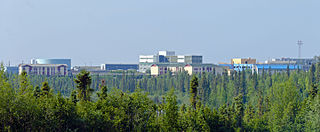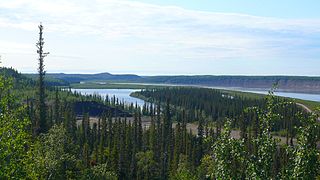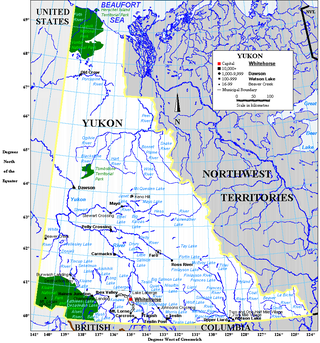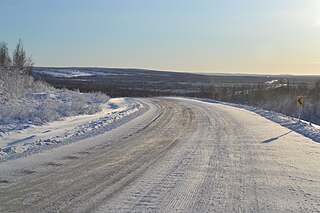
The Northwest Territories is a federal territory of Canada. At a land area of approximately 1,144,000 km2 (442,000 sq mi) and a 2016 census population of 41,790, it is the second-largest and the most populous of the three territories in Northern Canada. Its estimated population as of 2022 is 45,605. Yellowknife is the capital, most populous community, and only city in the territory; its population was 19,569 as of the 2016 census. It became the territorial capital in 1967, following recommendations by the Carrothers Commission.

Yukon is the smallest and westernmost of Canada's three territories. It also is the second-least populated province or territory in Canada, with a population of 43,964 as of March 2022. Whitehorse, the territorial capital, is the largest settlement in any of the three territories.

Inuvik is the only town in the Inuvik Region, and the third largest community in Canada's Northwest Territories. Located in what is sometimes called the Beaufort Delta Region, it serves as its administrative and service centre and is home to federal, territorial, and Indigenous government offices, along with the regional hospital and airport.

The Mackenzie River is a river in the Canadian boreal forest. It forms, along with the Slave, Peace, and Finlay, the longest river system in Canada, and includes the second largest drainage basin of any North American river after the Mississippi.

Numbered highways in Canada are split by province, and a majority are maintained by their province or territory transportation department. All highways in Canada are numbered except for three in the Northwest Territories, one in Alberta, one in Ontario, and one in Quebec. Ontario's 7000 series are not marked with their highway number but have been assigned one by the Ministry of Transportation. A number of highways in all provinces are better known locally by their name rather than their number. Some highways have additional letters added to their number: A is typically an alternate route, B is typically a business route, and other letters are used for bypass (truck) routes, connector routes, scenic routes, and spur routes. The territory of Nunavut has no highways.

Dawson City, officially the City of Dawson, is a town in the Canadian territory of Yukon. It is inseparably linked to the Klondike Gold Rush (1896–99). Its population was 1,577 as of the 2021 census, making it the second-largest town in Yukon.

Tuktoyaktuk, or TuktuyaaqtuuqIPA: [təktujaːqtuːq], is an Inuvialuit hamlet located in the Inuvik Region of the Northwest Territories, Canada, at the northern terminus of the Inuvik–Tuktoyaktuk Highway. Tuktoyaktuk, one of six Inuvialuit communities in the Inuvialuit Settlement Region, is commonly referred to simply by its first syllable, Tuk. The settlement lies north of the Arctic Circle on the shores of the Arctic Ocean, and is the only community in Canada on the Arctic Ocean that is connected to the rest of Canada by road. Formerly known as Port Brabant, the community was renamed in 1950 and was the first place in Canada to revert to the traditional Indigenous name.
The Roads to Resources Program was initiated by the Progressive Conservative government of Prime Minister of Canada John Diefenbaker from 1957 to 1963.

Yukon is in the northwestern corner of Canada and is bordered by Alaska and the Northwest Territories. The sparsely populated territory abounds with natural scenic beauty, with snowmelt lakes and perennial white-capped mountains, including many of Canada's highest mountains. The territory's climate is Arctic in territory north of Old Crow, subarctic in the region, between Whitehorse and Old Crow, and humid continental climate south of Whitehorse and in areas close to the British Columbia border. Most of the territory is boreal forest with tundra being the main vegetation zone only in the extreme north and at high elevations.

The Peel River is a tributary of the Mackenzie River in the Yukon and Northwest Territories in Canada. Its source is in the Ogilvie Mountains in the central Yukon at the confluence of the Ogilvie River and Blackstone River. Its main tributaries are:

Fort McPherson is a hamlet located in the Inuvik Region of the Northwest Territories, Canada. It is located on the east bank of the Peel River and is 121 km (75 mi) south of Inuvik on the Dempster Highway.

The history of Yukon covers the period from the arrival of Paleo-Indians through the Beringia land bridge approximately 20,000 years ago. In the 18th century, Russian explorers began to trade with the First Nations people along the Alaskan coast, and later established trade networks extending into Yukon. By the 19th century, traders from the Hudson's Bay Company were also active in the region. The region was administered as a part of the North-Western Territory until 1870, when the United Kingdom transferred the territory to Canada and it became the North-West Territories.

Tuktoyaktuk Winter Road, an extension of the Dempster Highway, was an ice road on frozen Mackenzie River delta channels and the frozen Arctic Ocean between the Northwest Territories communities of Inuvik and Tuktoyaktuk, in Canada. The road closed permanently on 29 April 2017 at the end of the 2016-2017 winter season. Construction of an all-season highway between Inuvik and Tuktoyaktuk commenced in April 2013; it opened on 15 November 2017.

The Inuvialuit Settlement Region, abbreviated as ISR, located in Canada's western Arctic, was designated in 1984 in the Inuvialuit Final Agreement by the Government of Canada for the Inuvialuit people. It spans 90,650 km2 (35,000 sq mi) of land, mostly above the tree line, and includes several subregions: the Beaufort Sea, the Mackenzie River delta, the northern portion of Yukon, and the northwest portion of the Northwest Territories. The ISR includes both Crown Lands and Inuvialuit Private Lands.

This is a list of Ice Road Truckers Season 2 episodes.
At the top of the world, there's an outpost like no other…and a job only a few would dare. The ice men return: two titans of the southern ice roads, and two contenders. Last season they drove loaded semis on frozen lakes…this year, the Arctic Ocean. Deeper into the deep freeze. Further out on thinner ice. The new mission: to haul the heavy metal of natural gas drilling rigs up a frozen river and across ice-choked seas. Ice road truckers have come to the edge of the earth. These are the men who make their living on thin ice.
Walter Muma is a Canadian man who is on record for completing a 3-month 11,500-mile (18,660 km) journey across Canada and Alaska by moped. The journey took place during the summer of 1978, began in Toronto, passed through Yukon and Alaska, continued up the Dempster Highway to Inuvik, Northwest Territories, and finally back to Toronto.

Francis Joseph Fitzgerald was a Canadian who became a celebrated Boer War veteran and the first commander of the Royal North-West Mounted Police detachment at Herschel Island in the Western Arctic (1903). From December 1910 until February 1911, he led a mail patrol from Fort McPherson southward to Dawson City. When the patrol did not arrive in time, a search party, led by Corporal William Dempster, was sent from Dawson City and found the bodies of Fitzgerald and the other patrol members. The trip became known as "The Lost Patrol" and as "one of Yukon’s greatest tragedies."

The history of the North-West Mounted Police in the Canadian north describes the activities of the North-West Mounted Police in the North-West Territories at the end of the 19th century and the start of the 20th. The mounted police had been established to control the prairies along the Canadian-United States border in 1873, but were then also deployed to control the Yukon region during the Klondike Gold Rush, and subsequently expanded their operations into the Hudson Bay area and the far north. The force was amalgamated in 1920 to form part of the new Royal Canadian Mounted Police, who continued their predecessors' work across the region.

The Inuvik–Tuktoyaktuk Highway (ITH), officially Northwest Territories Highway 10, is an all-weather road between Inuvik and Tuktoyaktuk in the Northwest Territories, Canada. It is the first all-weather road to Canada's Arctic Coast. The idea for the highway had been considered for decades; however, final approval was not until 2013, with construction beginning in 2014. It was officially opened on November 15, 2017, opening up Tuktoyaktuk to year-round vehicle traffic, which is hoped to increase tourism in the area.

William John Duncan Dempster was a member of the North-West Mounted Police (NWMP) in the Yukon Territory during the early 20th century. He gained notice for his involvement in finding the Lost Patrol, three NWMP officers and an ex-NWMP officer/guide who disappeared on the trail between Fort McPherson and Dawson City in the winter of 1910–11. The Dempster Highway in northern Canada is named for him.





























